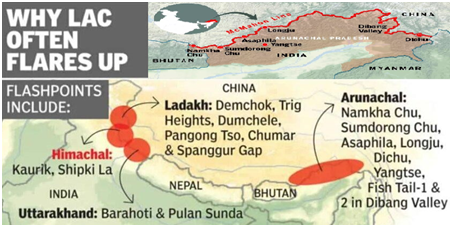Why in News?
- India withdrew its 8-athlete wushu contingent from the Summer World University Games, after China issued stapled visas to 3 athletes from the team who belong to Arunachal Pradesh.
What’s in Today’s Article?
- What is a Stapled Visa?
- Why does China issue Stapled Visas?
- Way Forward
What is a Stapled Visa?
- A stapled visa is simply an unstamped piece of paper that is attached by a pin or staples to a page of the passport and can be torn off or detached at will.
- This is different from a regular visa that is affixed to the passport by the issuing authority and stamped.
- China has made it a practice to issue stapled visas to Indian nationals from Arunachal Pradesh and J&K.
- It says the visas are valid documents, but the Government of India has consistently refused to accept this position.
- India’s long-standing and consistent position is that there should be no discrimination or differential treatment based on domicile or ethnicity in the visa regime.
Why does China issue Stapled Visas?
- Passports, visas, and other kinds of immigration controls reiterate the idea of a nation-state and its sovereignty which is inalienable and inviolable.
- A passport and visa entitle their holders to travel freely and under legal protection across international borders.
- China disputes India’s unequivocal and internationally accepted sovereignty over Arunachal Pradesh.
- Hence, they started the practice of issuing ‘stapled’ visas (since 2005-06) to all Indian citizens from Arunachal Pradesh.
- The stapled visas for J&K residents appear to have started around 2008-09.
What does China Claim?

- It challenges the legal status of the McMahon Line, the boundary between Tibet and British India that was agreed at the Convention Between Great Britain, China, and Tibet at the Shimla Convention of 1914.
- It is this disagreement that lies at the heart of Chinese claims over the position of the Line of Actual Control (LAC), and its repeated transgressions into Indian territory, undermining the sovereignty of India over parts of Indian territory.
- China claims some 90,000 sq. km of Arunachal Pradesh as its territory.
- It calls the area “Zangnan” in the Chinese language and makes repeated references to “South Tibet”.
- Chinese maps show Arunachal Pradesh as part of China.
Way Forward:
- Diplomatic engagement: To prevent misconceptions or a rise in strain in relations, it is essential to keep lines of communication open.
- India should underline its strength and power: Asserting its position at the negotiating table and emphasising that India is ready to protect its interests.
- Development of border infrastructure: Construction of border infrastructure, such as roads and bridges, can enable both nations access isolated areas and lessen the likelihood of confusion or conflicts.









